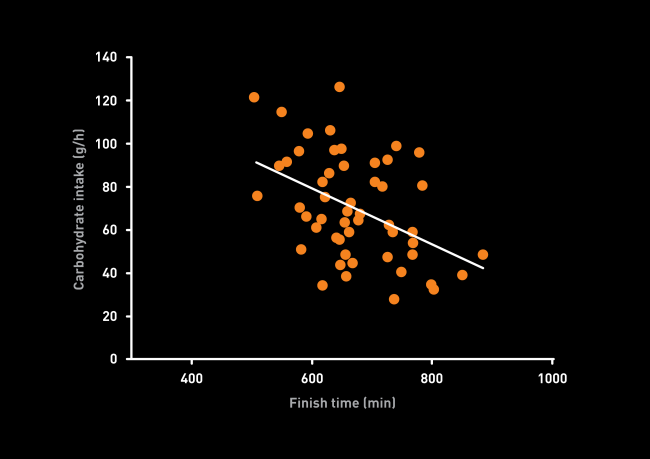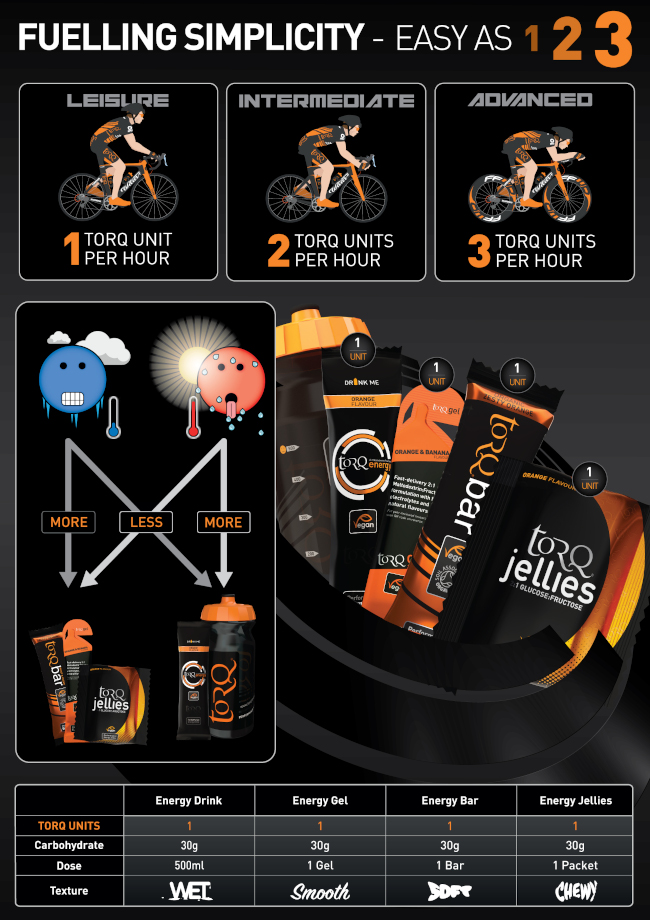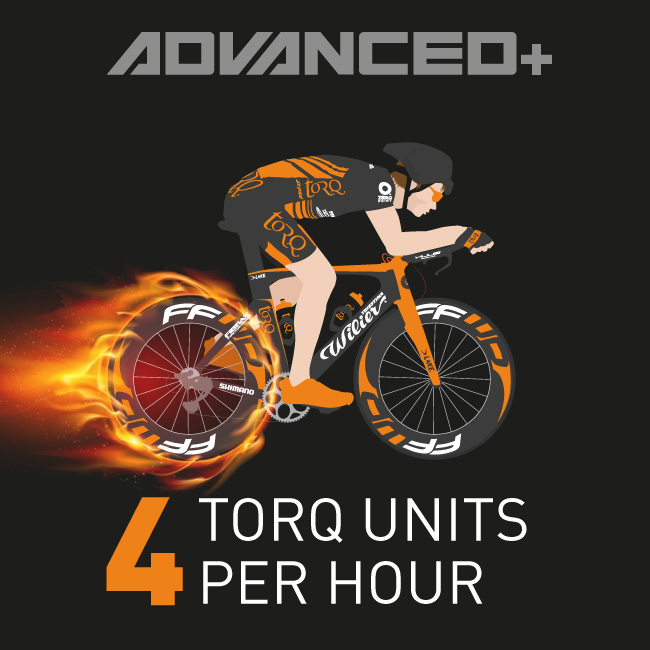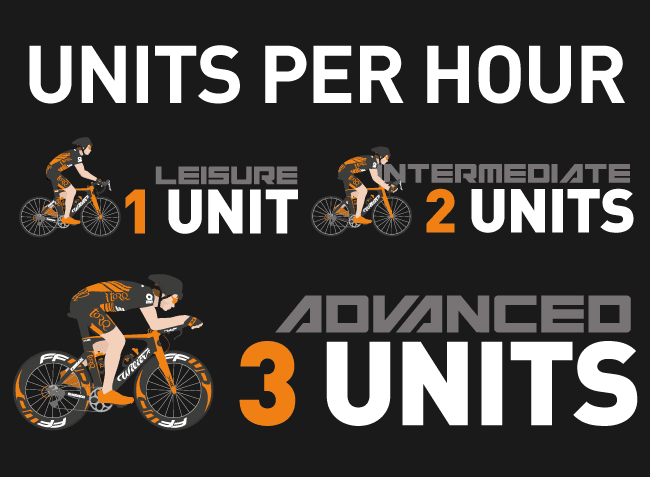The world of professional sport is an environment in which the word “stagnation” sends shivers down the spines of athletes and teams alike. The investment in new cutting-edge practices forever pushes the boundaries of performance, and nutrition is one area that is being forever refined. Optimised nutrition is allowing athletes to go faster, further and recover more quickly than ever before.
Carbohydrate Ingestion Rates in Professional Sport
With elite athletes being able to cycle, run and swim faster than ever before, the energy requirements of these efforts is also increasing and with that comes an increased need to fuel. It’s now frequently reported that elite athletes are pushing the scientifically recommended carbohydrate ingestion rates from 90g per hour to 120g of carbohydrate per hour. So, what does the data suggest about these exceptionally high carbohydrate ingestion rates?
A study from Pfeiffer et al., (2012) aimed to gather data insights into the nutritional practices of athletes in a real-world setting. The study documented fuel and fluid intake during professional Ironman races and explored how these nutritional interventions are linked to Ironman finishing times and the development of gastro-intestinal (GI) distress.
The graph below shows data collected from Ironman Hawaii 2009. With each dot representing an individual athlete, you can see how those who consumed more carbohydrate typically completed the Ironman in a faster time. Interestingly, the athlete who ingested 120g of carbohydrate per hour was the fastest to finish. It’s fair to say that the correlation between high carbohydrate ingestion and finishing time must not be overlooked. What’s interesting here is that the high carbohydrate practices the athletes were implementing were actually well ahead of the research!

But what about stomach upset or more scientifically referred to as gastrointestinal distress? Well, the prevalence of GI distress did increase as the carbohydrate ingestion rates increased. However the study suggested that this is most likely down to factors such as dehydration and overconsumption of carbohydrates which we will discuss in more detail later.
As we referred to above, the practices being implemented were ahead of the research. The research team in the Pfeiffer et al., (2012) study suggested that better advice was needed to support athletes to make more informed nutritional choices, especially when ingesting such high rates of carbohydrate. This type of education would help athletes determine a nutritional strategy that would support the specific demands of certain training sessions or races to maximise performance and/or training adaptation.
Skipping forward to the present day, this is a strategy that we see being implemented far more frequently – a concept known as “periodised nutrition”. Here athletes look at the demands of a days’ training sessions ahead of schedule and adapt their nutritional strategy accordingly, paying particular attention to their carbohydrate and hydration requirements.
Current Carbohydrate Recommendations
Variable hourly carbohydrate recommendations exist based upon the intensity and duration of the exercise session. It’s only in extreme circumstances where we see the established recommendations of 30g – 90g of carbohydrate per hour being exceeded to 120g per hour.
At this point, you may be wondering what 30, 60 or 90g of carbohydrate per hour looks like? Allow us to introduce you to the TORQ Fuelling System, a system meticulously refined from over 15 years of sports and exercise science research unrivalled by any other sports nutrition brand. The fuelling system has been painstakingly engineered to support the energy and hydration demands of your training and racing, built upon the carbohydrates recommendations highlighted above. Below we will take a look at specific circumstances, helping you to understand how many TORQ units you should be aiming to consume per hour based upon the current recommendations.
1 TORQ Unit (30g): If you’ve never really used energy and hydration products in a structured way before, start with just 1 TORQ Unit per hour. If for instance you’re completing a relaxed session at a sociable pace, but you plan on being out for a prolonged period of time, regularly consuming 30g carbohydrate will help you to enjoy the experience and you won’t feel so drained after you’ve finished.
If you do choose to try 1 TORQ Unit per hour and find that you run out of energy towards the end of your exercise session, consider moving up to 2 TORQ Units per hour on the following occasion and see if this fixes the problem. You don’t just have to be a novice to consider consuming 1 TORQ Unit per hour either. You could be a serious athlete, but the exercise session you have planned is so low in intensity that you require a much lower level of fuelling than you would if the intensity were to be higher.
2 TORQ Units (60g): If you’ve used energy products before and really want to notice a difference in your endurance performance, by extending your time to exhaustion and/or increasing the session intensity, stick diligently to 2 TORQ Units per hour. This will deliver some noticeable results. 2 TORQ Units per hour is a comfortable and effective level of fuelling and represents our default position here at TORQ.
3 TORQ Units (90g) Consuming 90 grams of carbohydrate per hour is optimal. 3 TORQ Units (90g carbohydrate) per hour is a unique offering by TORQ, because if it wasn’t for our meticulously consistent approach to product formulation across our drinks, gels, bars and jellies, this level of functional carbohydrate delivery just wouldn’t be possible. It’s at 3 TORQ Units per hour where the TORQ Fuelling System starts to deliver optimal performances. In the same way that a highly tuned sports car has to burn more fuel to deliver the performance the driver needs, if you want the best performances, the more fuel you can deliver to your muscles, the faster and further you will go.

What About 120g/4 TORQ Units Per Hour?
A recent study by Podlogar and colleagues (May 2022) looked at oxidation rates (carbohydrate burn rate) and fuel utilisation (from carbohydrates and fats) whilst comparing the consumption of 120g/h of a 1:0.8 Maltodextrin:Fructose formulation with 90g/h of a 2:1 Maltodextrin:Fructose formulation.
During endurance exercise, both fats and carbohydrates are burned as fuels. Notably, fat is held in a practically limitless supply within the human body, so there is no logic to following a carbohydrate fuelling strategy that forces the body to burn less of this abundant fuel. Let’s not forget that most training programs spend a huge amount of time developing the aerobic foundation allowing us to burn more of this abundant fuel.
This recent study from Podlogar and colleagues (May 2022), found that whilst carbohydrate oxidation rates (burn rates) were higher in the 1:0.8 group, fat utilisation dropped and was higher in the 2:1 group. This is significant and meant that the 1:0.8 group simply suppressed fat breakdown and increased carbohydrate metabolism whilst receiving no performance advantage. Furthermore, the study concluded that the 1:0.8 group didn’t benefit from any carbohydrate-sparing effect. This was despite the 1:0.8 group consuming 30g more carbohydrate per hour.
The take home message here is that there was no performance advantage or time to exhaustion advantage achieved by consuming 120g/h from a 1:0.8 formulation over consuming 90g per hour from a 2:1 formulation. In addition, the researchers noted that both stomach fullness and feelings of nausea were higher in the 1:0.8 group which could be attributed to overconsumption. This is supported by the data that showed in the last 60 minutes of the experimental trials that 86% of the ingested carbohydrate in the 90g/hr condition was burnt as a fuel, but in the last hour of the 120g condition, only 76% was burnt as a fuel, suggesting that carbohydrate was backing up in the gastro intestinal tract.
But let’s not rule out 120g/hr just yet…
A study by Virbay and colleagues (2020) demonstrated that 120g/hr of carbohydrate was achievable via a 2:1 ratio formulation. The research highlighted that mountain marathon runners absorbed a very high dose (120g/hr) of carbohydrate from a 2:1 Glucose: Fructose formulation, exactly the same carbohydrate formulation found within TORQ’s Fuelling System product range, and experienced little to no gastric upset in a real life race-paced mountain marathon event. Hardly any GI distress we hear you say?!
Prior to this event, all 26 elite/professional mountain marathon runners completed a 3-week bout of nutritional training, where the athletes would complete their weekly training commitments. During this time, they added nutritional progression by increasing the amount of carbohydrate consumed within each training session until they found themselves comfortable at ingesting 120g of carbohydrate per hour, equivalent to 4 TORQ units per hour. A major finding of this study was that biochemical markers of muscle damage in the 120g/hr group were significantly lower than groups consuming 60 – 90g/hr. This highlights that muscle fatigue is likely to have been reduced, offering stronger potential for exercise performance to be maintained during longer duration events, but also holds significance for races where limited periods of recovery are key to the race outcome, such as multi-day stage racing.

Training The Gut for 120g Per Hour
We cover the topic of gastrointestinal training in-depth in our Training the Digestive System article. However, we will touch on how the mechanisms of how the gut training may have helped participants in the study from Virbay and colleagues (2020) to consume 120g/hr with very little GI distress and reduce markers of muscle damage.
A study from Cox et al., (2010) saw two groups train 16 hours per week for 28 days. One group consumed a moderate carbohydrate diet, achieving 5g/kg body weight of carbohydrate a day. This carbohydrate was consumed during exercise and outside of the exercise window.
The second group was named the ‘high carbohydrate group’. This group had the same baseline diet of 5g/kg body weight of carbohydrate per day, but they also received an additional 1.5g/kg body weight of carbohydrate per hour from a glucose-only drink during exercise (purposely exceeding the known glucose absorption threshold of 60g/hr).
After 28 days, both groups completed a 100-minute steady state ride at a moderate exercise intensity while consuming a high carbohydrate glucose-only drink. The main outcome of this study was that the group that consumed the high carbohydrate diet with a high energy glucose drink during exercise were able to absorb and burn more carbohydrate during the exercise test, while there was no change for the control group. The reason for this increase in oxidation (burn rate) may have been due to an increase in the activity of the SGLT-1 glucose transporter, allowing for a greater absorption and delivery of carbohydrate to the blood and thus the muscles.
Although the amount of glucose burnt in this study did not exceed much beyond the known glucose threshold of 60g/hr, increasing only to a modest 63.6g from 54g, the data did suggest that glucose transportation could be trained and this can only result in a better tolerance of the carbohydrate. This resulted in less carbohydrate backing up in the intestinal tract and more carbohydrate being delivered as a fuel. We can confidently suggest that the gastrointestinal transporter for fructose (GLUT-5) may also have the capacity to be trained and tolerate more fructose than previously thought.

Don't Neglect Hydration
When ingesting high rates of carbohydrate (90-120g/hr), your margins for error become ever tighter, so it’s important to get the balance between fuelling and hydration correct.
When we ingest carbohydrate, whether this be a via a TORQ product or any other form, the carbohydrate must be transported from the small intestine to the blood. Unlike water, carbohydrate doesn’t have the ability to pass through the intestinal wall via passive transport (osmosis). As we discussed in the last section, there are different transporters for different types of carbohydrate, but the important one from a fuelling and hydration perspective is SGLT-1 (sodium, glucose transporter 1). As the name suggests, for the transporter to function we need both glucose (carbohydrate),sodium and a whopping 260 water molecules! Therefore, it’s easy to see that if we become dehydrated, the water isn’t available for the SGLT-1 transporter to function correctly. The result being that carbohydrate backs up in the gastrointestinal tract and GI distress starts to develop.
You can see the glucose transporter in action by viewing the short animation below.

Should I Consume 120g/h?
There is growing evidence suggesting that some athletes can tolerate up to 120g of carbohydrate per hour and that this may enhance performance. This rate of fuelling may be beneficial for elite athletes and for highly competitive multistage events and races.
However, research is still uncertain about how athletes manage to handle such large amounts of fuel and whether there is a true performance advantage. The key takeaway is that consuming very high rates of carbohydrates should be approached gradually, allowing your gut time to adapt. It’s also important to remember that just because some athletes can tolerate more than 90 grams of carbs per hour, it doesn’t necessarily mean that everyone should target that level of fuelling. Also, we must remember that fuelling recommendations are built upon training intensity and duration so unless training intensity and duration is exceptionally high, it’s unlikely that there is a need to achieve such high fuelling rates. From our 25-year experience, we also know that is rare to see people confidently achieve the traditional 90g/h recommended targets, so we believe that this should be the first step to optimising your fuelling. As the saying goes, you need to learn walk, before you can run. That said, if you can tolerate these exceptionally high ingestion rates, and your training session or race demands high rates of fuelling, then we see no problem fuelling with 4 TORQ units per hour.

Conclusion
In the ever-evolving world of professional sports, optimising nutrition is key to enhancing performance. Increasing carbohydrate intake to 120g per hour is showing promise for elite athletes, yet it also poses risks, especially concerning gastrointestinal issues if factors such as hydration are overlooked. While this higher intake can be beneficial under extreme conditions, most athletes should aim to perfect fuelling with 90g per hour guideline before progressing onto 120g per hour.
As sports science advances, periodised nutrition will likely become more common, helping athletes fine-tune their fuelling strategies. Balancing evidence-based practices with individual needs can offer a significant competitive edge.
References
Pfeiffer, B., Stellingwerff, T., Hodgson, A.B., Randell, R., Pöttgen, K., Res, P. and Jeukendrup, A.E., 2012. Nutritional intake and gastrointestinal problems during competitive endurance events. Medicine & Science in Sports & Exercise, 44(2), pp.344-351
Jeukendrup, A., 2014. A step towards personalized sports nutrition: carbohydrate intake during exercise. Sports medicine, 44(Suppl 1), pp.25-33.
Viribay, A., Arribalzaga, S., Mielgo-Ayuso, J., Castañeda-Babarro, A., Seco-Calvo, J. and Urdampilleta, A., 2020. Effects of 120 g/h of carbohydrates intake during a mountain marathon on exercise-induced muscle damage in elite runners. Nutrients, 12(5), p.1367.
Loo, D.D., Zeuthen, T., Chandy, G. and Wright, E.M., 1996. Cotransport of water by the Na+/glucose cotransporter. Proceedings of the National Academy of Sciences, 93(23), pp.13367-13370.
Cox, G.R., Clark, S.A., Cox, A.J., Halson, S.L., Hargreaves, M., Hawley, J.A., Jeacocke, N., Snow, R.J., Yeo, W.K. and Burke, L.M., 2010. Daily training with high carbohydrate availability increases exogenous carbohydrate oxidation during endurance cycling. Journal of Applied Physiology, 109(1), pp.126-134.




